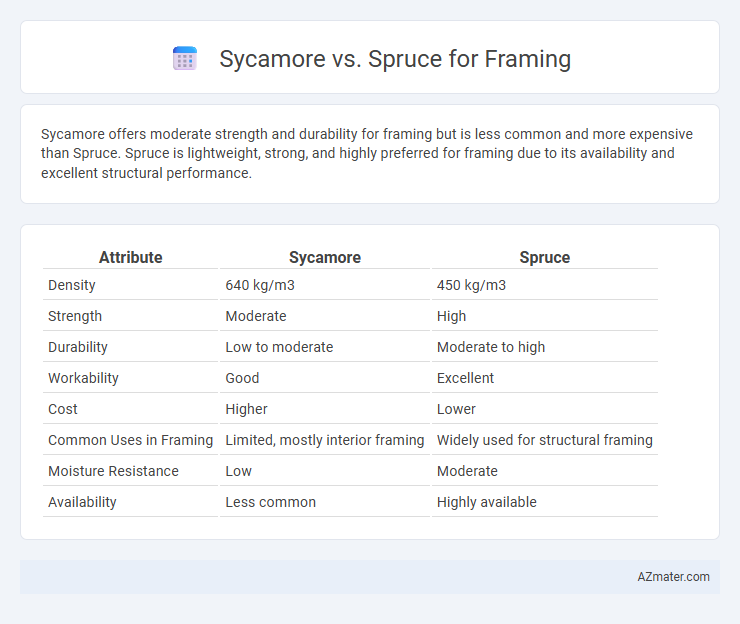Sycamore offers moderate strength and durability for framing but is less common and more expensive than Spruce. Spruce is lightweight, strong, and highly preferred for framing due to its availability and excellent structural performance.
Table of Comparison
| Attribute | Sycamore | Spruce |
|---|---|---|
| Density | 640 kg/m3 | 450 kg/m3 |
| Strength | Moderate | High |
| Durability | Low to moderate | Moderate to high |
| Workability | Good | Excellent |
| Cost | Higher | Lower |
| Common Uses in Framing | Limited, mostly interior framing | Widely used for structural framing |
| Moisture Resistance | Low | Moderate |
| Availability | Less common | Highly available |
Introduction: Sycamore vs Spruce for Framing
Sycamore and Spruce differ significantly in framing applications due to their distinct density and structural properties. Spruce, known for its lightweight yet strong characteristics, is commonly preferred in construction for its consistent grain and ease of handling. Sycamore offers a harder and heavier alternative but is less frequently used in framing because it can be more challenging to work with and lacks the uniformity ideal for structural support.
Wood Identification: Sycamore and Spruce Characteristics
Sycamore wood features a coarse, interlocking grain with a pale creamy color and occasional darker streaks, making it distinct in texture and appearance compared to spruce. Spruce wood exhibits a straight, fine grain with a light yellowish-white hue, known for its uniform texture and high strength-to-weight ratio. Identifying these woods based on grain patterns, color, and texture is crucial for selecting the appropriate material in framing applications.
Strength and Durability Comparison
Sycamore wood offers moderate strength but lacks the high load-bearing capacity required for structural framing, making it less suitable compared to spruce. Spruce is widely favored in construction for its superior strength-to-weight ratio and excellent durability under stress, ensuring long-lasting structural integrity. The natural resistance of spruce to warping and its consistent grain pattern enhance framing stability, whereas sycamore's tendency to be softer and more prone to wear limits its effectiveness in framing applications.
Workability and Ease of Use
Sycamore wood offers moderate workability with a fine, even texture and good machining properties, making it relatively straightforward for framing applications. Spruce is highly favored for framing due to its lightweight nature, straight grain, and excellent ease of use, allowing for quick cuts and efficient nailing without splitting. Both woods perform well, but spruce's superior workability and ease of handling often make it the preferred choice for structural framing projects.
Resistance to Pests and Decay
Sycamore wood exhibits moderate resistance to pests but is less durable against decay compared to spruce, which offers better natural resistance to both fungi and insects, making it more suitable for framing in environments prone to moisture and pest exposure. Spruce's tight grain structure and resin content enhance its defense against termites and wood-boring beetles, contributing to longer frame longevity. Sycamore requires additional treatment or chemical preservatives to reach comparable pest and decay resistance levels necessary for structural framing applications.
Cost and Availability
Sycamore wood is generally more expensive and less readily available than spruce, which is widely sourced and favored for framing due to its affordability and abundant supply. Spruce offers a cost-effective solution with consistent availability in lumber markets, making it a preferred choice for large-scale construction projects. Sycamore's higher price and limited availability can impact project budgets and timelines, restricting its use primarily to specialty or aesthetic framing applications.
Environmental Impact and Sustainability
Sycamore wood has a moderate environmental impact due to its slower growth rate and limited availability compared to spruce, which grows rapidly and is more widely harvested, enhancing its sustainability profile for framing. Spruce's fast growth cycle allows for quicker forest regeneration and carbon sequestration, making it a preferred choice in eco-friendly construction projects. However, responsibly sourced sycamore from well-managed forests also contributes to sustainable framing by preserving biodiversity and maintaining soil health.
Common Construction Applications
Sycamore and spruce both serve important roles in construction framing, with spruce favored for its high strength-to-weight ratio and consistent grain, making it ideal for wall studs, floor joists, and roof trusses. Sycamore, while less common in framing, is valued for its durability and resistance to decay, often used in structural elements exposed to moisture or requiring long-term stability. Spruce's availability and ease of workability make it the preferred choice in large-scale residential and commercial framing projects where dimensional accuracy and mechanical properties are critical.
Aesthetic Differences: Grain and Color
Sycamore framing offers a lighter, cream-colored wood with a distinct, irregular grain pattern that creates a unique, rustic aesthetic, while spruce features a consistent, straight grain with a pale yellow to light brown hue, providing a more uniform and traditional look. The fine, close grain of spruce makes it ideal for smooth finishes, whereas sycamore's pronounced grain texture adds a natural character often preferred in decorative framing. Color stability varies, with spruce maintaining a steady tone over time, while sycamore may darken slightly, enhancing its warm and organic appearance.
Conclusion: Which Wood is Better for Framing?
Spruce is generally better for framing due to its superior strength-to-weight ratio, durability, and resistance to warping compared to sycamore. Sycamore's denser grain can make it harder to work with and less cost-effective for large-scale construction. Spruce's widespread availability and consistent structural properties make it the preferred choice for framing in residential and commercial projects.

Infographic: Sycamore vs Spruce for Framing
 azmater.com
azmater.com